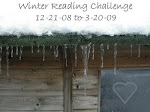 When Alan, the beadle of the manor of Bampton, does not return from his nightly duties monitoring the village curfew, his young wife Matilda seeks out Master Hugh de Singleton, a well-respected surgeon and bailiff of the manor, to find out where Alan could have gone and what could have delayed him.
When Alan, the beadle of the manor of Bampton, does not return from his nightly duties monitoring the village curfew, his young wife Matilda seeks out Master Hugh de Singleton, a well-respected surgeon and bailiff of the manor, to find out where Alan could have gone and what could have delayed him.
Two days later Alan's corpse is discovered in the brush along the track to St. Andrew's Chapel. His body is almost unrecognizable so Master Hugh is immediately suspicious of the coroner's conclusion that a wolf had caused Alan's death. But who among this small village of believers could be responsible? And is the threat still imminent?My Review:This marvelous book is written in the first-person narrative of Hugh de Singleton, a surgeon during medieval England. Right off, a corpse is discovered and suspicions arise. Was it a wolf or other wild animal, or could it be a murder?
Master Hugh solves the puzzle like any good sleuth. He notes the clues and follows up on his hunches--all the while tending to his duties as the only physician. I like that Master Hugh shares his day-to-day experiences. Quite interesting to me is learning about the practice of medicine during this time. He visits and often quotes his mentor, John Wyclif.
I read the author's first novel
The Unquiet Bones, loved it and looked forward to reading this second in the series. Both are stand alone novels, and you'll have no problem catching on. However, if you've read the first, you will enjoy picking up where the first novel ends as well as the reappearance of Alice.
The dialogue is a delight, and the author has researched medieval England extensively to create a believable plot.
An extensive glossary makes the novel easier to read. All in all, this is a delightful book, and I recommend this to one and all! I look forward to the next in the series.
I want to give a special thanks to Cat Hoort at Kregel Publications for my copy.
Here is the first chapter:

I awoke at dawn the ninth day of April, 1365. Unlike French Malmsey, the day did not improve with age.
There have been many days I awoke at dawn but remembered not the circumstances three weeks hence. I remember this day not because of when I awoke, but why, and what I was compelled to do after. Odd, is it not, how one extraordinary event will burn even the mundane surrounding it into a man’s memory.
I have seen other memorable days in my twenty-five years. I recall the day my brother Henry died of plague. I was a child, but I remember well Father Aymer administering extreme unction. Father Aymer wore a spice bag about his neck to protect him from the malady. It did not, and he also succumbed within a fortnight. I can see the pouch yet, in my mind’s eye, swinging from the priest’s neck on a hempen cord as he bent over my stricken brother.
I remember clearly the day in 1361 when William of Garstang died. William and I and two others shared a room on St. Michael’s Street, Oxford, while we studied at Baliol College. I comforted William as the returning plague covered his body with erupting buboes. For my small service he gave me, with his last breaths, his three books. One of these volumes was, Surgery, by Henry de Mondeville. How William came by this clumes I know not. But I see now in this gift the hand of God, for I read de Mondeville’s work and changed my vocation.
Was it then God’s will that William die a miserable death so that I might find God’s vision for my life? This I cannot accept, for I saw William’s body covered with oozing pustules. I will not believe such a death is God’s choice for any man. Here I must admit a disagreement with Master Wyclif, who believes that all is foreordained. But out of evil God may draw good, as I believe He did when he introduced me to the practice of surgery. Perhaps the good I have done with my skills balances the torment William suffered in his death. But not for William.
I remember well the day I met Lord Gilbert Talbot. I stitched him up after his leg was opened by a kick from a groom’s horse on Oxford High Street. This needlework opened my life to service to Lord Gilbert and the townsmen of Bampton, and brought me also the post of bailiff on Lord Gilbert’s manor at Bampton.
Other days return to my mind with less pleasure. I will not soon forget Christmas Day, 1363, and the feast that day at Lord Gilbert’s Goodrich Castle hall. I had traveled there from Bampton to attend Lord Gilbert’s sister, the Lady Joan. The fair Joan had broken a wrist in a fall from a horse. I was summoned to set the break. It was foolish of me to think I might win this lady, but love has hoped more foolishness than that. A few days before Christmas a guest, Sir Thomas de Burgh, arrived at Goodrich. Lord Gilbert invited him knowing well he might be a thief. Indeed, he stole Lady Joan’s heart. Between the second and third removes of the Christmas feast he stood and for all in the hall to see offered Lady Joan a clove-studded pear. She took the fruit and with a smile delicately drew a clove from the pear with her teeth. They married in September, a few days before Michealmas, last year.
But I digress.
I awoke at dawn to thumping on my chamber door. I blinked sleep from my eyes, crawled from my bed, and stumbled to the door. I opened it as William the porter was about to rap on it again.
“It’s Alan . . . . the beadle. He’s found.”
Alan had left his home to seek those who would violate curfew two days earlier. He never returned. His young wife came to me in alarm the morning of the next day. I sent John Holcutt, the reeve, to gather a party of searchers, but they found no trace of the man. John was not pleased to lose a day of work from six men. Plowing of fallow fields was not yet finished. Before I retired Wednesday evening John sought me out and begged not to resume the search next day. I agreed. If Alan could not be found with the entire town aware of his absence another day of poking into haymows and barns seemed likely also to be fruitless. It was not necessary.
“Has he come home?” I asked..
“Nay. An’ not likely to, but on a hurdle.”
“He’s dead?”
“Aye.”
“Where was he found?”
“Aside t’way near to St. Andrew’s Chapel.”
It was no wonder the searchers had not found him. St. Andrew’s Chapel was near half a mile to the east. What, I wondered, drew him away from the town on his duties?
“Hubert Shillside has been told. He would have you accompany him to the place.”
“Send word I will see him straightaway.”
I suppose I was suspicious already that this death was not natural. I believe it to be a character flaw if a man be too mistrustful. But there are occasions in my professions – surgery and bailiff – when it is good to doubt a first impression. Alan was not yet thirty years old. He had a half-yardland of Lord Gilbert Talbot and was so well thought of that despite his youth Lord Gilbert’s tenants had at hallmote chosen him beadle these three years. He worked diligently, and bragged all winter that his four acres of oats had brought him nearly five bushels for every bushel of seed. A remarkable accomplishment, for his land was no better than any other surrounding Bampton. This success brought also some envy, I think, and perhaps there were wives who contrasted his achievement to the work of their husbands. But this, I thought, was no reason to kill a man.
I suppose a man may have enemies which even his friends know not of. I did consider Alan a friend, as did most others of the town. On my walk from Bampton Castle to Hubert Shillside’s shop and house on Church View Street I persuaded myself that this must be a natural death. Of course, when a corpse is found in open country, the hue and cry must be raised even if the body be stiff and cold. So Hubert, the town coroner, and I, bailiff and surgeon, must do our work.
Alan was found but a few minutes from the town. Down Rosemary Lane to the High Street, then left on Bushey Row to the path to St. Andrew’s Chapel. We saw – Hubert and I, and John Holcutt, who came also – where the body lay while we were yet far off. As we passed the last house on the lane east from Bampton to the chapel we saw a group of men standing in the track at a place where last year’s fallow was being plowed for spring planting. They saw us approach, and stepped back respectfully as we reached them.
A hedgerow had grown up among rocks between the lane and the field. New leaves of pale green decorated stalks of nettles, thistles, and wild roses. Had the foliage matured for another fortnight Alan might have gone undiscovered. But two plowmen, getting an early start on their day’s labor, found the corpse as they turned the oxen at the end of their first furrow. It had been barely light enough to see the white foot protruding from the hedgerow. The plowman who goaded the team saw it as he prodded the lead beasts to turn them.
Alan’s body was invisible from the road, but by pushing back nettles and thorns – carefully – we could see him curled as if asleep amongst the brambles. I directed two onlookers to retrieve the body. Rank has its privileges. Better they be nettle-stung than we. A few minutes later Alan the beadle lay stretched out on the path.
Laying in the open, on the road, the beadle did not seem so at peace as in the hedgerow. Deep scratches lacerated his face, hands, and forearms. His clothes were torn, and a great wound bloodied his neck where flesh had been torn away. The coroner bent to examine this injury more closely.
“Some beast has done this, I think,” he muttered as he stood. “See how his surcoat is torn at the arms, as if he tried to defend himself from fangs.
I knelt on the opposite side of the corpse to view in my turn the wound which took the life of Alan the beadle. It seemed as Hubert Shillside said. Puncture wounds spread across neck and arms, and rips on surcoat and flesh indicated where claws and fangs had made their mark. I sent the reeve back to the Bampton Castle for a horse on which to transport Alan back to the town and to his wife. The others who stood in the path began to drift away. The plowmen who found him returned to their team. Soon only the coroner and I remained to guard the corpse. It needed guarding. Already a vulture floated high above the path.
I could not put my unease into words, so spoke nothing of my suspicion to Shillside. But I was not satisfied that some wild beast had done this thing. I believe the coroner was apprehensive of his explanation as well, for it was he who broke the silence.
“There have been no wolves hereabouts in my lifetime,” he mused, “nor wild dogs, I think.”
“I have heard,” I replied, “Lord Gilbert speak of wolves near Goodrich. And Pembroke. Those castles are near to the Forest of Dean and the Welsh mountains. But even there in such wild country they are seldom seen.”
Shillside was silent again as we studied the body at our feet. My eyes wandered to the path where Alan lay. When I did not find what I sought I walked a few paces toward the town, then reversed my path and inspected the track in the direction of St. Andrew’s Chapel. My search was fruitless.
Hubert watched my movements with growing interest. “What do you seek?” He finally asked. It was clear to him I looked for something in the road.
“Tracks. If an animal did this there should be some sign, I think. The mud is soft.”
“Perhaps,” the coroner replied. “But we and many others have stood about near an hour. Any marks a beast might have made have surely been trampled underfoot.”
I agreed that might be. But another thought also troubled me. “There should be much blood,” I said, “but I see little.”
“Why so?” Shillside asked.
“When a man’s neck is torn as Alan’s is there is much blood lost. It is the cause of death. Do you see much blood hereabouts?”
“Perhaps the ground absorbed it?”
“Perhaps . . . . let us look in the hedgerow, where we found him.”
We did, carefully prying the nettles apart. The foliage was depressed where Alan lay, but only a trace of blood could be seen on the occasional new leaf or rock or blade of grass.
“There is blood here,” I announced, “but not much. Not enough.”
“Enough for what?” the coroner asked with furrowed brow.
“Enough that the loss of blood would kill a man.”
Shillside was silent for a moment. “Your words trouble me,” he said finally. “If this wound,” he looked to Alan’s neck, “did not kill him, what did?”
“T’is a puzzle,” I agreed.
“And see how we found him amongst the nettles. Perhaps he dragged himself there to escape the beasts, if more than one set upon him.”
“Or perhaps the animal dragged him there,” I added. But I did not believe this for reasons I could not explain.
It was the coroner’s turn to cast his eyes about. “His staff,” Shillside mused, “I wonder where it might be?”
I remembered the staff. Whenever the beadle went out of an evening to watch and warn he carried with him a yew pole taller than himself and thick as a man’s forearm. I spoke to him of this weapon once. A whack from it, he said, would convince the most unruly drunk to leave the streets and seek his bed.
“He was proud of that cudgel,” Hubert remarked as we combed the hedgerow in search of it. “He carved an ‘A’ on it so all would know t’was his.”
“I didn’t know he could write.”
“Oh . . . . he could not,” Shillside explained. “Father Thomas showed him the mark and Alan inscribed it. Right proud of it, he was.”
We found the staff far off the path, where some waste land verged on to a wood just behind St. Andrew’s Chapel. It lay thirty paces or more from the place where Alan’s body had lain in the hedgerow.
“How did it come to be here?” Shillside asked. As if I would know. He examined the club; “there is his mark . . . . see.” He pointed to the “A” inscribed with some artistry into the tough wood.
As the coroner held the staff before me I inspected it closely and was troubled. Shillside saw my frown.
“What perplexes you, Hugh?”
“The staff is unmarked. Were I carrying such a weapon and a wolf set upon me I would flail it about to defend myself; perhaps hold it before me so the beast caught it in his teeth rather than my arm.”
Shillside peered at the pole and turned it to view all sides. Its surface was smooth and unmarred. “Perhaps,” he said thoughtfully, “Alan swung it at the beast and lost his grip. See how polished smooth it is . . . . and it flew from his grasp to land here.”
“That might be how it was,” I agreed, for I had no better explanation.
As we returned to the path we saw the reeve approach with Bruce, the old horse who saw me about the countryside when I found it necessary to travel. He would be a calm and dignified platform on which to transport a corpse.
We bent to lift Alan to Bruce’s back, John at the feet and Shillside and me at the shoulders. As we swung him up Alan’s head fell back. So much of his neck was shredded that it provided little support. I reached out a hand to steady the head and felt a thing which made my hackles rise.
“Wait,” I said, rather sharply, for my companions started and gazed in wonder at me. “Set him back on the road.”
I turned the beadle’s head and felt the place on the skull which had startled me. There was a soft lump on the skull, just behind Alan’s right ear. This swelling was invisible for the thick shock of hair which covered it. I spread the thatch and inspected Alan’s scalp, then showed my discovery to reeve and coroner.
John Holcutt was silent, but Shillside, after running his fingers across the swelling looked at me and asked, “How could a wolf do this?”

 A mother recounts the story of the day her child was born, and then takes the child on an imaginary trip around the world to meet other children born on the same day.
A mother recounts the story of the day her child was born, and then takes the child on an imaginary trip around the world to meet other children born on the same day.





























